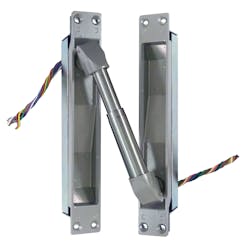Wired hinges and pivots provide an attractive, concealed and vandal-resistant method of carrying power data and communications from the stationary door frame to components mounted in the movable door.
Wired hinges and power transfers evolved from another product group referred to as door loops. Door loops typically are surface-mounted on the door and frame and are popular for retrofitting existing openings when going from mechanical to electric locks.
A major drawback to using surface-mounted door loops is that they’re obvious and, thus, a magnet for vandals as well as subject to incidental damage from collisions with people and things passing through the door. They also sometimes get caught between the door and the frame.
We used door loops for retrofitting access control readers and locks on the front doors to banks to restrict entry to alcoves after hours. During those times, only individuals who wished to transact business on the ATM had a legitimate reason to be in the alcove. The surface-mounted door loops were wired in series with maglocks, a popular locking solution for banks.
Yanking a door loop out of the frame would open the circuit to the maglock and unlock the door. Often other damage was caused to the door frame and locking system. Repairing these systems was a priority issue for the banks, because it represented a major liability and deterred customers from using the ATM.
So, alternatives to surface-mounted door loops should be employed whenever feasible.
Many types of power transfers are available:
- Wired hinges, which come in butt, continuous or pivot styles
- Mortised power transfers
- Concealed door loops
- Wireless power transfers
- Armored power transfer devices, which are aimed at harsh environments and special applications
The broader your knowledge is of the products available, the better you’ll be able to specify the most appropriate solution for any application.
Following are some examples of individual products:
SDC power transfer products
SDC provides a range of power-transfer devices, including concealed mortise devices, wired hinges and wireless power transfer devices. All are UL-listed for 3-hour fire-rated doors.
Power transfer hinges. Electrified hinges provide a concealed and vandal-resistant method for running wires from the frame to doors equipped with electric locks and exit devices.
Power transfer loops. Surface and concealed mortise-mount power transfer loops allow you to run wires from the frame to transfer power and monitoring signals to doors.
Power transfer mortise. This heavy-duty device provides a concealed and secure means of transferring electric lock and exit device power and signal wires from the frame to the door. The device is concealed when the door is closed, and it’s aimed at heavy traffic and applications that require higher security to inhibit tampering and abuse. For power transfers that mount on the hinge edge of the door, if the door isn’t hollow, it might be necessary to “core drill” the door from the location of the lock to the location of the hinge. SDC has a kit that lets you do this.
Wireless power transfer devices. The WPT series uses a radio-frequency (RF) transmitter to send energy wirelessly across the door gap to a receiver that converts the energy to DC voltage to power electrified locks and latches. Retrofitting electrified locks into openings that have wood doors is simpler and less time-consuming, and core drilling the door isn’t necessary. The WPT works well with steel doors, too. The WPT allows for transfer of latchbolt monitoring, REX or data signals.
More info: sdcsecurity.com
ABH power transfer products
ABH makes several power-transfer devices. These include electrified hinge options. One is the A570TW. This is a 5-inch removable section that includes concealed Thru-Wires for ease of installation and available on full-surface applications.
Another option is the PT1000 Power Transfer series device. This device can be concealed when the door is closed. It’s aimed at high-abuse and heavy-traffic situations.
More info: www.abhmfg.com
ROFU power transfer products
ROFU has various models of power transfers and hinges. These include standard door loops but also devices that transfer power from the frame to the door leaf. These come in two-pin and three-pin versions.
Rofu tells us that future plans include a “12/24 VDC induction power transfer” and a six-wire power transfer hinge coming in 2022. Stay tuned.
More info: rofu.com
Command Access CDL
The Concealed Door Loop (CDL) is a low-cost method of transferring low-voltage power from the door frame to the locking device. The CDL slides into the door or frame and is concealed completely when the door is closed. It’s designed for continuous- and butt-hinge applications that are full mortise, half mortise or half surface and have a standard throw.
The CDL comes in three lengths — 6, 12 and 18 inches — with several cap-finish options.
More info: www.commandaccess.com
Securitron PowerJump ICPT
The Securitron PowerJump ICPT by ASSA ABLOY Electronic Security Hardware transfers power wirelessly across the door gap to run electrified hardware on the door. It can transfer power across door gaps of up to three-sixteenths of an inch.
The PowerJump ICPT eliminates the necessity to cross drill or snake wires through the door, and it has flexible mounting. It can be installed on the hinge side, latch side or top of the door frame.
It’s intended for use with electrified locks, latches or other door hardware that requires up to 6 watts (0.5A@12VDC) of power.
More info: www.securitron.com
Tim O’Leary is an experienced security consultant and a regular contributor to Locksmith Ledger.
About the Author
Tim O'Leary
Tim O'Leary is a security consultant, trainer and technician who has also been writing articles on all areas of locksmithing & physical security for many years.
